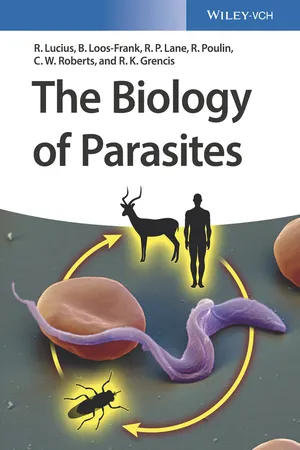
eBook - ePub
The Biology of Parasites
Richard Lucius, Brigitte Loos-Frank, Richard P. Lane, Robert Poulin, Craig Roberts, Richard K. Grencis, Ron Shankland, Renate FitzRoy
This is a test
Condividi libro
- English
- ePUB (disponibile sull'app)
- Disponibile su iOS e Android
eBook - ePub
The Biology of Parasites
Richard Lucius, Brigitte Loos-Frank, Richard P. Lane, Robert Poulin, Craig Roberts, Richard K. Grencis, Ron Shankland, Renate FitzRoy
Dettagli del libro
Anteprima del libro
Indice dei contenuti
Citazioni
Informazioni sul libro
This heavily illustrated text teaches parasitology from a biological perspective. It combines classical descriptive biology of parasites with modern cell and molecular biology approaches, and also addresses parasite evolution and ecology.
Parasites found in mammals, non-mammalian vertebrates, and invertebrates are systematically treated, incorporating the latest knowledge about their cell and molecular biology. In doing so, it greatly extends classical parasitology textbooks and prepares the reader for a career in basic and applied parasitology.
Domande frequenti
Come faccio ad annullare l'abbonamento?
È semplicissimo: basta accedere alla sezione Account nelle Impostazioni e cliccare su "Annulla abbonamento". Dopo la cancellazione, l'abbonamento rimarrà attivo per il periodo rimanente già pagato. Per maggiori informazioni, clicca qui
È possibile scaricare libri? Se sì, come?
Al momento è possibile scaricare tramite l'app tutti i nostri libri ePub mobile-friendly. Anche la maggior parte dei nostri PDF è scaricabile e stiamo lavorando per rendere disponibile quanto prima il download di tutti gli altri file. Per maggiori informazioni, clicca qui
Che differenza c'è tra i piani?
Entrambi i piani ti danno accesso illimitato alla libreria e a tutte le funzionalità di Perlego. Le uniche differenze sono il prezzo e il periodo di abbonamento: con il piano annuale risparmierai circa il 30% rispetto a 12 rate con quello mensile.
Cos'è Perlego?
Perlego è un servizio di abbonamento a testi accademici, che ti permette di accedere a un'intera libreria online a un prezzo inferiore rispetto a quello che pagheresti per acquistare un singolo libro al mese. Con oltre 1 milione di testi suddivisi in più di 1.000 categorie, troverai sicuramente ciò che fa per te! Per maggiori informazioni, clicca qui.
Perlego supporta la sintesi vocale?
Cerca l'icona Sintesi vocale nel prossimo libro che leggerai per verificare se è possibile riprodurre l'audio. Questo strumento permette di leggere il testo a voce alta, evidenziandolo man mano che la lettura procede. Puoi aumentare o diminuire la velocità della sintesi vocale, oppure sospendere la riproduzione. Per maggiori informazioni, clicca qui.
The Biology of Parasites è disponibile online in formato PDF/ePub?
Sì, puoi accedere a The Biology of Parasites di Richard Lucius, Brigitte Loos-Frank, Richard P. Lane, Robert Poulin, Craig Roberts, Richard K. Grencis, Ron Shankland, Renate FitzRoy in formato PDF e/o ePub, così come ad altri libri molto apprezzati nelle sezioni relative a Biological Sciences e Neuroscience. Scopri oltre 1 milione di libri disponibili nel nostro catalogo.
Informazioni
Chapter 1
General Aspects of Parasite Biology
Richard Lucius and Robert Poulin
- 1.1 Introduction to Parasitology and Its Terminology
- 1.1.1 Parasites
- 1.1.2 Types of Interactions Between Different Species
- 1.1.2.1 Mutualistic Relationships
- 1.1.2.2 Antagonistic Relationships
- 1.1.3 Different Forms of Parasitism
- 1.1.4 Parasites and Hosts
- 1.1.5 Modes of Transmission
- Further Reading
- 1.2 What Is Unique About Parasites?
- 1.2.1 A Very Peculiar Habitat: The Host
- 1.2.2 Specific Morphological and Physiological Adaptations
- 1.2.3 Flexible Strategies of Reproduction
- Further Reading
- 1.3 The Impact of Parasites on Host Individuals and Host Populations
- Further Reading
- 1.4 Parasite–Host Coevolution
- 1.4.1 Main Features of Coevolution
- 1.4.2 Role of Alleles in Coevolution
- 1.4.3 Rareness Is an Advantage
- 1.4.4 Malaria as an Example of Coevolution
- Further Reading
- 1.5 Influence of Parasites on Mate Choice
- Further Reading
- 1.6 Immunobiology of Parasites
- 1.6.1 Defense Mechanisms of Hosts
- 1.6.1.1 Innate Immune Responses (Innate Immunity)
- 1.6.1.2 Acquired Immune Responses (Adaptive Immunity)
- 1.6.1.3 Scenarios of Defense Reactions Against Parasites
- 1.6.1.4 Immunopathology
- 1.6.2 Immune Evasion
- 1.6.3 Parasites as Opportunistic Pathogens
- 1.6.4 Hygiene Hypothesis: Do Parasites Have a Good Side?
- 1.6.1 Defense Mechanisms of Hosts
- Further Reading
- 1.7 How Parasites Alter Their Hosts
- 1.7.1 Alterations of Host Cells
- 1.7.2 Intrusion into the Hormonal System of the Host
- 1.7.3 Changing the Behavior of Hosts
- 1.7.3.1 Increase in the Transmission of Parasites by Bloodsucking Vectors
- 1.7.3.2 Increase in Transmission Through the Food Chain
- 1.7.3.3 Introduction into the Food Chain
- 1.7.3.4 Changes in Habitat Preference
- Further Reading
1.1 Introduction to Parasitology and Its Terminology
1.1.1 Parasites
Parasites are organisms which live in or on another organism, drawing sustenance from the host and causing it harm. These include animals, plants, fungi, bacteria, and viruses, which live as host-dependent guests. Parasitism is one of the most successful and widespread ways of life. Some authors estimate that more than 50% of all eukaryotic organisms are parasitic, or have at least one parasitic phase during their life cycle. There is no complete biodiversity inventory to verify this assumption; it does stand to reason, however, given the fact that parasites live in or on almost every multicellular animal, and many host species are infected with several parasite species specifically adapted to them. Some of the most important human parasites are listed in Table 1.1.
Table 1.1 Occurrence and distribution of the more common human parasites
| Parasite | Infected people (in millions) | Distribution |
| Giardia lamblia | >200 | Worldwide |
| Trichomonas vaginalis | 173 | Worldwide |
| Entamoeba histolytica | 500* | Worldwide in warm climates |
| Trypanosoma brucei | 0.01 | Sub-Saharan Africa (“Tsetse Belt”) |
| Trypanosoma cruzi | 7 | Central and South America |
| Leishmania spp. | 2 | Near + Middle East, Asia, Africa, Central and South America |
| Toxoplasma gondii | 1500 | Worldwide |
| Plasmodium spp. | >200 | Africa, Asia, Central and South America |
| Paragonimus sp. | 20 | Africa, Asia, South America |
| Schistosoma sp. | >200 | Asia, Africa, South America |
| Hymenolepis nana | 75 | worldwide |
| Taenia saginata | 77 | Worldwide |
| Trichuris trichiura | 902 | Worldwide in warm climates |
| Strongyloides stercoralis | 70 | Worldwide |
| Enterobius vermicularis | 200 | Worldwide |
| Ascaris lumbricoides | 1273 | Worldwide |
| Ancylostoma duodenale and Necator americanus | 900 | Worldwide in warm climates |
| Onchocerca volvulus | 17 | Sub-Saharan Africa, Central and South America |
| Wuchereria bancrofti | 107 | Worldwide in the tropics |
Source: Compiled from various authors.
*many of those asymptomtic or infected with the morphologically identical Entamoeba dispar.
The term parasite originated in Ancient Greece. It is derived from the Greek word “parasitos” (Greek pará = on, at, beside; sítos = food). The name parasite was first used to describe the officials who participated in sacrificial meals on behalf of the general public and wined and dined at public expense. It was later applied to minions who ingratiated themselves with the rich, paying them compliments and practicing buffoonery to gain entry to banquets where they would snatch some food.
The result was a character figure, a type of Harlequin, who had a fixed role to play in the Greek comedy of classical antiquity (Figure 1.1). Later, “parasitus” also became an integral part of social life in Roman antiquity. It also reappeared in European theater in pieces such as Friedrich Schiller's “Der Parasit.” In the seventeenth century, botanists were already describing parasitic plants such as mistletoe as parasites; in his 1735 standard work “Systema naturae,” Linnaeus first used the term “specie parasitica” for tapeworms in its modern biological sense.

Figure 1.1 Parasitos mask, a miniature of a theater mask of Greek comedy; terracotta, around 100 B.C. (From Myrine (Asia Minor); antiquities collection of the Berlin State Museums. Image: Courtesy of Thomas Schmid-Dankward.)
The delimitation of the term “parasite” to organisms which profit from a heterospecific host is very important for the definition itself. Interactions between individuals of the same species are thus excluded, even if the benefits of such interactions are very often unequally distributed in the colonies of social insects and naked mole rats, for instance, or in human societies. As a result, the interaction between parents and their offspring does not fall under this category, although the direct or indirect manner in which the offspring feed from their parent organism can at times be reminiscent of parasitism.
The principle of one side (the parasite) taking advantage of the other (the host) applies to viruses, all pathogenic microorganisms, and multicellular parasites alike. This is why we often find that no clear distinction is made between prokaryotic and eukaryotic parasites. With regard to parasites, we usually do not differentiate between viruses, bacteria, and fungi on the one hand and animal parasites on the other; we tend to see only the common parasitic lifestyle. Even molecules to which a function in the organism cannot be assigned are sometimes described as parasitic, such as prions, for example, the causative agent of spongiform encephalopathy, or apparently functionless “selfish” DNA plasmids that are present in the genome of many plants. Many biologists are of the opinion that only parasitic protozoa, parasitic worms (helminths), and parasitic arthropods are parasites in the strict sense of the term. Parasitology, as a field, is concerned only with those groups, while viruses, bacteria, fungi, and parasitic plants are dealt with by other disciplines. This restriction clearly hampers cooperation with other disciplines, something that seems antiquated in today's modern biology, where all of life's processes are traced back to DNA; it is gratifying that the boundaries have relaxed in recent years. However, eukaryotic parasites are distinguished from viruses and bacteria by their comparatively higher complexity, which implies slower reproduction and less genetic flexibility. These traits typically drive eukaryotic parasites to establish long-standing connections with their hosts, using strategies different from the “hit-and-run” strategies used by many viruses and bacteria....